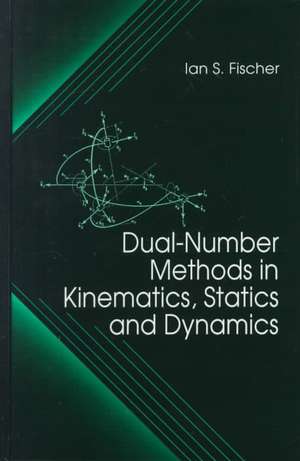Dual-Number Methods in Kinematics, Statics and Dynamics
Autor Ian Fischeren Limba Engleză Hardback – 12 noi 1998
Dual-Number Methods in Kinematics, Statics and Dynamics serves as a text for a course using dual-number methods as well as a manual for the reader to develop his or her abilities for the design of machinery or evaluation of mechanical systems. In addition to the explanatory text and derivations, the author includes numerous examples and exercises to enable the reader to gain insight and perfect skills.
Preț: 1518.29 lei
Preț vechi: 1668.45 lei
-9% Nou
Puncte Express: 2277
Preț estimativ în valută:
290.53€ • 310.67$ • 242.23£
290.53€ • 310.67$ • 242.23£
Carte disponibilă
Livrare economică 28 martie-11 aprilie
Livrare express 13-19 martie pentru 32.04 lei
Preluare comenzi: 021 569.72.76
Specificații
ISBN-13: 9780849391156
ISBN-10: 0849391156
Pagini: 242
Ilustrații: 828 equations; 10 Tables, black and white
Dimensiuni: 152 x 229 x 18 mm
Greutate: 0.49 kg
Ediția:1
Editura: CRC Press
Colecția CRC Press
ISBN-10: 0849391156
Pagini: 242
Ilustrații: 828 equations; 10 Tables, black and white
Dimensiuni: 152 x 229 x 18 mm
Greutate: 0.49 kg
Ediția:1
Editura: CRC Press
Colecția CRC Press
Public țintă
ProfessionalCuprins
Definitions. Coordinate Transformation. Matrix Modeling of Joints and Links. Displacement Analysis. Velocity Analysis. Static Analysis. Dynamic Analysis. Dual-Number Programming. Bibliography. Index.
NTI/Sales Copy
NTI/Sales Copy
Recenzii
"Exciting!...of tremendous benefit to graduate-level classes and researchers in the kinematics, mechanisms, and robotics communities."
- Prof. Pierre Larochelle, Mechanical Engineering Program, Florida Institute of Technology, Melbourne
- Prof. Pierre Larochelle, Mechanical Engineering Program, Florida Institute of Technology, Melbourne
Descriere
Dual-Number Methods in Kinematics, Statics and Dynamics uses 3x3 coordinate-transformation matrices and 3-element vectors with dual-number elements to analyze the mechanics of mechanisms, robots, and other mechanical systems. It presents a comprehensive explanation of dual-number concepts, coordinate-transformations, and applications and includes numerous examples and exercises to enable the reader to gain insight and perfect skills. The author includes a chapter about programming with dual-number variables and provides a sample C++ program for an application that clearly shows advantages obtained from the dual-number formulation.












